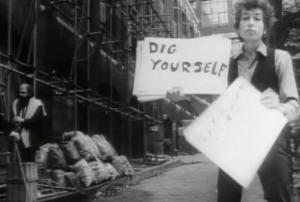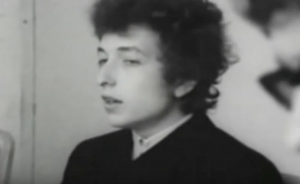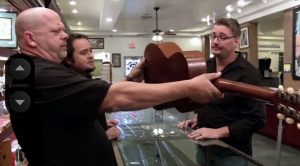Rapper Danny Brown on the landing channel of Vania Heymann’s 2013 video for Bob Dylan’s 1965 masterpiece, ‘Like a Rolling Stone’, immediately co-opting the past and present with a likeness to Dylan’s wiley-haired ‘Highway 61 Revisited’ peak prowess.
ICYMI in 1965, Bob Dylan, adding to his cache of nobel-rock laurels, was a defining figure in the evolution of the music video, arguably creating the lyric hybrid format with Bringing it All Back Home’s “Subterranean Homesick Blues,” flipping lyric cue cards in a Manhattan alley.

Dylan and poet Allen Ginsberg in the official video for ‘Subterranean Homesick Blues’; Photo: BobDylanVEVO
Even then he was blowing up the medium with multi-layered meta tricks, changing up the lyrics on the fly, landmark beat poet Allen Ginsberg making a cameo as a rabbi in the periphery.
Add a pair of Wayfarers to his head at 1:52 when Dylan threads the fourth verse of the song’s anti-establishment “look out kid” theme, paired in the video with a cue card reading “dig yourself,” and it would’ve been a marketing team’s wet dream.
Dylan’s (and his collaborators’) genius are myriad, and one of the greatest frames around this is his cognizance and defiance of it all. He’s tongue-in-cheek on tongue-in-cheek on tongue-in-cheek. He cemented this untouchable blend of iconoclasm and literati brand in this same year when he berated Time journalist Horace Judson for essentially being fake news, proceeding to sacrifice the guy for perpetuating a systematic cultural ignorance to ideas.

Dylan speaks to ‘Time’ Journalist, Horace Judson, in D.A. Pennebaker’s ‘Don’t Look Back’; Photo: Docurama/YouTube
“I got nothing to say about these things I write. I just write ’em. I don’t need to say anything about ’em. I don’t write ’em for any reason. There’s no great message. If you want to tell other people that, go ahead and tell em,” Dylan wryly says to Judson, immortalized in D.A. Pennebaker’s rockumentary, Don’t Look Back.
All of this is important because in the half of a century of a career since, there have been misteps and sidesteps and WTF-steps over the years as all man, artist and brand — the 76-year-old’s latest venture: ‘Heaven’s Door’ whiskey — but re: Dylan’s in-on-it crowning achievement, with one move, he can thread the whole messy quilt together.
Now five years old, Isreali viral director prodigy Vania Heymann’s 2013 treatment of Dylan’s Highway 61 Revisited masterpiece, “Like a Rolling Stone,” is a simultaneous marketing masterpiece of a wink to Dylan’s legacy and a nod to that systematic no-idea media cultural ignorace incubated in 1965 that if anything has only become more terrifyingly pervasive with every consecutive tweet from Donald Trump.

An actress in the ShopTV segment of Heymann’s interactive video for ‘Like a Rolling Stone’; Photo: eko
At first watch, one might take it as a jump-the-shark moment that cashes in on the gimmickery of interactive videos, set as a 16-channel-flipping lip-sync reel with everything from BBC news to ESPN’s SportsCenter to ShopTV correspondents, anchors and actors mouthing the infamous lyrics of the not-fit-for-radio six-minute plus edit of the song.
Or, if you want to cut deeper, perhaps there are some out there that feel like that infamous dude who just couldn’t accept that folk was dead and screamed “Judas” at an electric guitar-wielding Dylan.
Though much like the song itself, rock’s greatest patchwork about the loss of innocence both internal and external, morphing from punk to R&B, held together by Dylan’s perfectly imperfect nasally howl, the layers start to fray in this destined way as you flip-away into a punchline of a comatose tv-viewer with channels, channels everywhere, but not a show to watch.
Seamlessly edited by the digital media company Interlude, “Like a Rolling Stone”s characters from ‘Miss Lonely’ to the ‘Jugglers and the Clowns’ to the chrome horse-riding diplomat with a siamese cat take a temporary sensory backseat to The Price is Right, the guys from Pawn Stars, a History Channel segment, until you get hooked in by the chorus and you find yourself singing along to a woman trying to sell you a dustbuster and a magic brush asking you how it feels “to be on your own, with no direction home, like a complete unknown.”
The History Channel bit reveals itself as an expose on The Great Depression, the Pawn Stars are selling an acoustic guitar (a brilliant nod to Dylan going electric) Drew Carey is hawking prizes through a big sparkly wheel on The Price is Right. There’s a kids show, reality TV, a chef whipping up “Childhood Flavors,” rapper Danny Brown eating street food for six-minutes; all their own little microcosms of the lies and feels and deals narrative to “Like a Rolling Stone.”
To be stocked with all these brands that are both complicit and subversively derided with a 50+ year old song, that is able to interactively entrap the viewer into this soul-sucking reflection of himself and the degenerative effects the media has on society sometimes, Heymann and Dylan set the bar here.
The way of experiential videos, at least in the music arena, even when considering Arcade Fire’s multiple brilliant contributions i.e. placing viewers in nostalgia trips through satellite imagery of their own neighborhoods in promotion of their album, The Suburbs, or Beck’s ambitious 360-degree video for his take on David Bowie’s ‘Sound and Vision’, both of which were created by director Chris Milk, there’s nothing that compares.
And if you want to quantify that in a feeling, well, this video added another person to that very short list capable of answering that.
Watch Heymann’s full video at http://video.bobdylan.com/.
Tags: Bob Dylan


